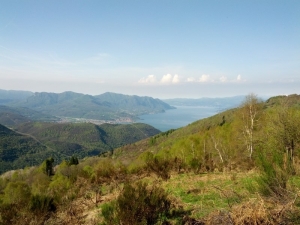The valleys of the Luinese, that is of the area around Luino, are located in the northern part of the province of Varese and appear to the visitor as entirely covered with large deciduous forests.
The vegetation is characterized by chestnut trees (Castanea sativa), whose spread has been widely favoured by man to the detriment of down oak woods (Quercus pubescens) and sessile oaks (Quercus petraea). As well as chestnut trees, other common species are hazel trees (Corylus avellana), wild cherry trees (Prunus avium), common ash trees (Fraxinus excelsior) and little-leaf lindens (Tilia cordata). Wide woods of European beech trees (Fagus sylvatica) cover more humid slopes between 900 and 1,400-1,500 metres.
Green alders (Alnus viridis) and hairy alpenroses (Rhododendron hirsutum) grow at higher altitudes as well as pastures, consisting mainly of Nardus stricta, Poa alpina and Festuca spicata. Reforestation with conifers began in the early decades of the last century as the pine forest of Armio and the pine forest of Montegrino show.
The geology of the area is quite varied. The area north of Luino is characterized by mica schists and gneiss, sometimes interspersed with quartzite streaks, while the area south of Luino presents vast outcrops of limestone rocks. The retreat of the Ticino glacier left numerous traces: glacial valleys, the fluvial-glacial terraces in Val Veddasca, the tops of rounded hills (Forcora, Monte Sirti, Paglione, Monte Borgna, Monte Lema), glacial erratics.
The progressive neglect of mountain farming and the depopulation of the valleys, which began in the post- WWII period, brought about new environmental situations which proved suitable to the life of a variety of wildlife: the chamois (Rupicapra rupicapra), living at decidedly low altitudes for the species, and other ungulates such as the roe deer (Capreolus capreolus), the red deer (Cervus elaphus), the wild boar (Sus scropha). Badgers (Meles meles), pine martens (Martes martes), beech martens (Martes foina), weasels (Mustela nivalis), foxes (Vulpes vulpes) inhabit there together with more common micro-mammals (rodents and insectivores).
The area is also very rich in bird life with typical mountain species such as the golden eagle (Aquila chrysaetus), the common raven (Corvus corax) and the black grouse (Lyrurus Tetrix). The amphibians comprise the common frog and the agile frog (Rana temporaria, Rana Dalmatina), the green frog (Rana esculenta), the toad (Bufo bufo), the tree frog (Hyla arborea), the fire salamander (Salamander salamander) and the crested newt (Triturus cristatus). As to the reptiles, adders (Vipera aspis), though excessively feared, are very important to the ecosystem as well as grass snakes (Natrix natrix), viperine water snakes (Natrix maura), rat snakes (Coluber viridiflavus) and green lizards (Lacerta viridis).
Val Veddasca, one of these valleys, has recently been listed in the Sites of Community Importance (SIC).
The Valleys of the Luinese

Via Luini 16
21016 Luino - Varese
tel. 0332 511101
email: cailuino@cailuino.it
PEC: luino@pec.cai.it
PIVA: 01664110127
Seguici su facebook

